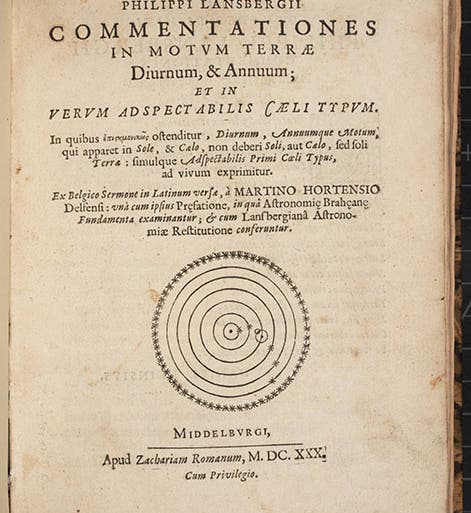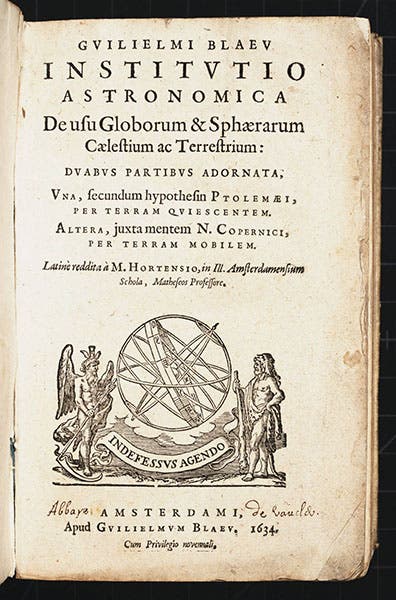Scientist of the Day - Martinus Hortensius
Martinus Hortensius, a Dutch astronomer also known as Maarten van den Hove, died Aug. 7, 1639, at the age of about 34; his birth date is unknown. Hortensius was one of those lesser-rank scientists who are never mentioned in surveys of early modern science, but who played important roles in facilitating the completion and dissemination of the work of better-known figures whom we do learn about. Hortensius was the young disciple of an aged astronomer, Philippe van Lansberge, one of the first defenders of the Copernican cosmology in the Netherlands. Lansberge wrote a popular account of the Copernican system and published it in Dutch in 1629. Hortensius translated the work into Latin and published it in 1630 as Commentaries on the diurnal and annual Motion of the Earth (first image). It was a best-seller, the first popular explanation of heliocentric astronomy, appearing two years before Galileo’s Dialogue (1632). It also contained an introduction by Hortensius that was highly critical of the work of Tycho Brahe and his followers, especially their disregard for ancient astronomy. We have both Lansberge's Dutch edition and Hortensius' translation in our History of Science collection.
Hortensius also did much of the calculations for Lansberge's major opus, his collection of astronomical tables that was published in 1632. The work has an elaborate Copernican engraved title page that we discussed in an earlier post on Lansberge. It is not known if Hortensiius had a hand in the iconography of that engraving.
Hortenius also was responsible for translating a work of perhaps the second Copernican in the Netherlands, Willem Janszoon Blaeau. Blaeu was a globe and map maker and managed to build a mechanical sphere on Copernican principles. He wrote a book about mechanical globes, both Ptolemaic and Copernican, and Hortensius tranlated this into Latin as well, as Institutio astronomica (1634). We have this work also in our collections; you can see Hortenius’s name near the bottom of the title page, as the translator into Latin.
We have one work by Hortensius himself, a defense of a treatise by Pierre Gassendi, who was the first to observe a transit of Mercury across the Sun, and was surprised to discover that Mercury was much smaller (and therefore much further away) that anyone had suspected. Hortensiius's Dissertatio de Mercurio in Sole viso et venere invisa (1633) has not been scanned, and will not be until things return to normal in the world.
Hortenius was appointed a professor in Amsterdam in 1634 and was clearly on the rise. In 1639, he was offered a professorship at Leiden, but before he could accept the position, he died, of causes unknown. Who knows what he might have accomplished had he been awarded another 20 or 30 years of life. We would probably then have a portrait to help us remember him.
Dr. William B. Ashworth, Jr., Consultant for the History of Science, Linda Hall Library and Associate Professor emeritus, Department of History, University of Missouri-Kansas City. Comments or corrections are welcome; please direct to ashworthw@umkc.edu.







